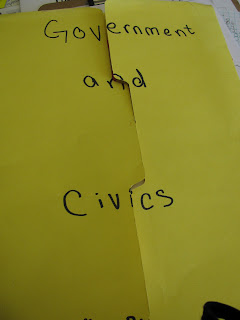According to the Tennessee standards the students are to identify and explain each of the three parts of the constitution; the preamble, the articles, and the Bill of Rights. Within each section students should understand the purposes, the branches of government, the levels of government (local, state, federal) and their individual responsibilities. We will be adding amendments to the pocket on the right as we progress through American history. By the end of the year we'll have amendments 13, 14, 15, 16, 18, 19, 21, and 25 (in addition to the Bill of Rights).
We examined the preamble and then dissected what the preamble tells us about the constitution. We used dictionaries, thesauruses, and prior knowledge to help make it more meaningful.
How a bill becomes a law
We of course watched the School House Rock song, but we learned more in depth about the process. To incorporate writing we worked on persuasive writing and wrote letters to our congressperson about ideas we had to make East Tennessee/Johnson City a better place. We wrote the process out like a timeline.
Branches of the Government
This is a pretty straight forward flipbook. The only modification I made was to have them split the legislative door into two parts (senate and house of representatives).


Another focus of Tennessee standards is to analyze how the state government was set up to mirror the federal government. We did this through examining the two constitutions and looking for similarities and differences.


Levels of Government
The circles were made using a cardstock stencil that I made and the students can cut and assemble with a brad. I like how they interlock with each other to show smallest to largest and how the local government must still work within the state government's constitution (etc).
The Bill of Rights
I'd mentioned on a previous post how we go about learning the Bill of Rights. This is the flip book that we made to keep the information in our lapbooks. I traced the alphabetical organizer cards from an index card box and then made lines and numbered them. The students then just had to cut them out and assemble to prepare to write down the information.
This pocket will be used for the additional amendments we learn about as we progress through American History!
I hope you see something that you might be able to take away and try in your classroom! Although some of this is specific to Tennessee I'm sure there are parallel lessons that could be done for any state.
Mrs. J
This is a (somewhat) new blog. Follow me to get updates!



















































